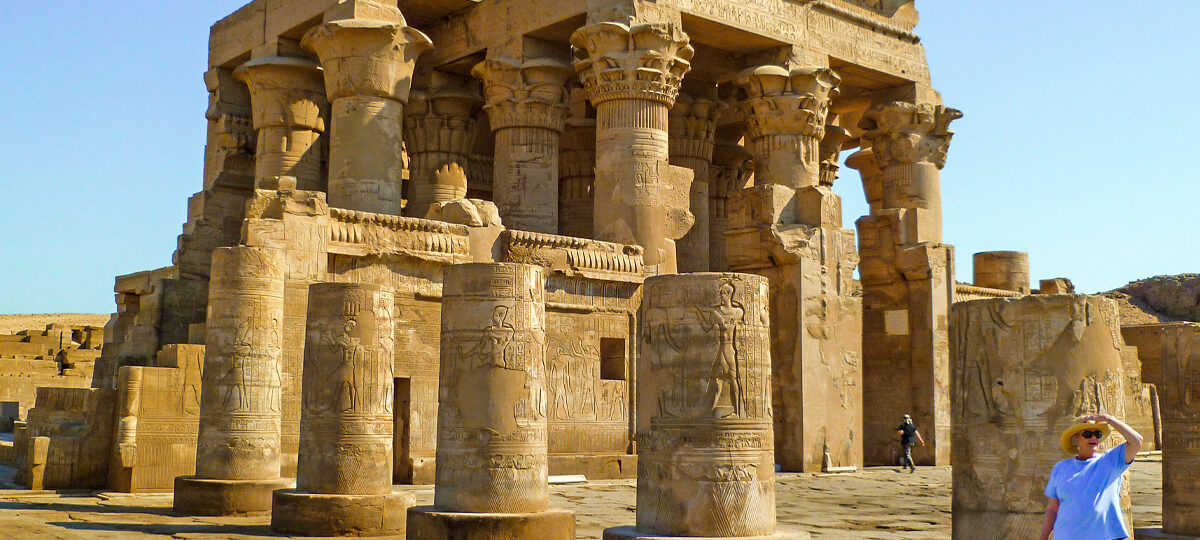Kom Ombo Temple
The Kom Ombo temple is on the east bank of the Nile, about 40 km north of Aswan. It is on a small hill made of stone and sand. The stories about how it was built and how it was destroyed are just as interesting as the amazing Ptolemaic architecture Kom Ombo is a misspelling of Ombos, an ancient Egyptian city whose name comes from the Egyptian word for gold, nwbt.
In ancient Egypt, this city was very important because it was at the start of the trade caravan routes that went to Nubia through the Nile Valley. Because of this, the city of Ombos has been a stronghold for every empire that has ruled Egypt (Kom Ombo).
A Brief Look at the Temple of Kom Ombo.
The Temple of Kom Ombo in Egypt is one of the most well-known buildings of its kind in the whole country because of its perfect symmetry. Both of its entrances lead to Hypostyle Halls, which are covered by columns and surrounded by sanctuaries. Because the temple is a shrine to both Horus (or Haroeris) and Sobek, this is the case. Even though this temple is mostly made up of two separate buildings, there are many areas that are shared.
In the second century B.C., when the Ptolemaic dynasty was in power, work on the temple began. Several additions were made while the Romans were in charge. This is why there are so many Roman and Greek ideas in the building. Some of the Roman emperors are shown in bas-reliefs on the pylon at the entrance. Augustus built the pylon, which shows different Roman rulers paying homage to Egyptian gods.
Tools that were used to surgically dig up the Kom Ombo Temple Egyptian medicine was very advanced for its time, but it was always affected by the country’s strong religious and magical traditions. The dentist is just one example of a doctor who knew another doctor from their time in the Ancient Empire. Herodotus, on the other hand, says that all doctors knew a lot about medicine and could treat any sickness.
Based on the medical criteria, there were three likely diagnoses for the disorders, which were:
- The first person to say, “This is a disease I know and will cure,” when they actually knew how to fix the problem, would be a genius.
- Two, when they were treating someone, they would say, “This is a condition I know and will treat,” even if they didn’t know what would happen.
- The third is, “This is a disease I don’t know and won’t treat.” This is often said when the doctor is sure that the patient’s condition is fatal.

Outside the temple, there is a beautiful relief of the god Imhotep with many books and tools for healing from that time. One thing that will surprise you is how much the medical tools of the time are like those of today.
In the medically relevant scenario, Emperor Trajan stands before the Egyptian God Imhotep, who built the first pyramid, the step pyramid. Imhotep was well-known as both a doctor and a priest. In this temple, Trajan knelt down in front of a sitting Imhotep and made sacrifices to honor Imhotep as the God of Medicine.
Some of the beautiful parts are medical tools, ponds for sterilization, and a picture of Isis sitting and helping women give birth Since it is surrounded by two stone walls on all sides, the main temple has two deambulatories. In the back wall of the inner wall, there were two rooms and a central stairway to get in.
The Temple is a one-of-a-kind structure because it is really two symmetrical temples that face each other along a longitudinal axis. Every part of the structure is exactly the same in each of the two temples. It has two pylons, two entrances, two courtyards, two Hypostyle rooms, and two sanctuaries. Because one side would worship Horus and the other would worship Sobek.
Sober’s is in the south, and Haroeris’s is in the north. In each of these places, you can still see the black diorite altars. This holy building was also called the House of the Crocodile and the Castle of the Falcon.
Haroeris and his family (wife Tasenetnefret and son Panebtawy) as well as Sobek (god of fertility and co-creator of the universe with Hathor and Khonsu) are shown in the temple as triads.
The Egyptians used a calendar to keep track of the days, months, and years. A calendar is a system that uses numbers to keep track of time. It was very important to understand the Egyptian calendar.
There are three parts to a year: the flood, planting, and gathering. A season has four months, and a month has 30 days. There are a total of 360 days in a year with 30 weeks. Forgotten Days are the five days that are missing from a year. They correspond to the four major gods (Isis, Osiris, Seth, and Nephthys) and the deity Horus.
Keep in mind that this scene at the temple of Kom Ombo was a key part of figuring out how the Egyptians counted.

